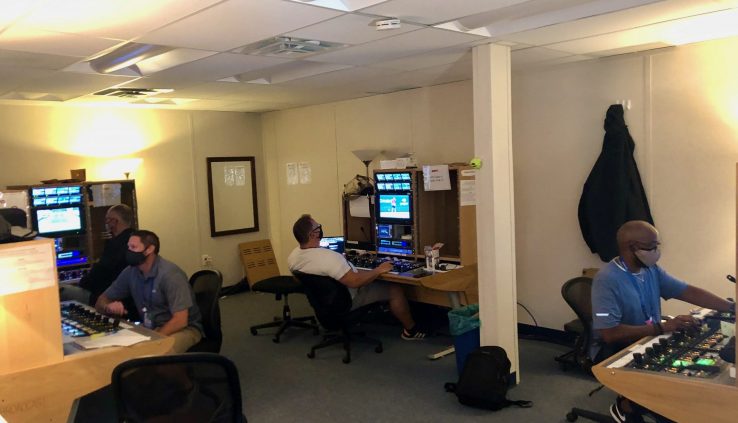SimplyLive: US Open Returns: How ESPN’s Biggest Production Was Transformed
By Adam Noyes
It’s no secret that Covid-19 has caused a major disruption in the live sports industry since early 2020. Now, some major sporting events are returning, taking safety concerns into account. This means different workflows, lighter attendance, and a greater need for streaming.
One such even is the US Open, which will return this year being streamed by ESPN, with a slightly different workflow than in the past. ESPN will be relying on SimplyLive production systems.
Check out some highlights from an article on sportsvideo.org to learn more.
In the age of the COVID-19 pandemic, one of the first big challenges was to make sure that everyone could get onsite. A key technology partner for ESPN is Gravity Media, which provides the equipment and integration support for the Open.
“The Gravity Media team is from the UK, and all of the equipment comes from the UK,” says Cleary. “There were a lot of unknowns about whether we would be able to get their engineers and personnel into the country when there was a travel ban.”
The USTA faced a similar situation and worked closely with various federal, state, and local government agencies to get the necessary clearances.
“Until we knew that we could get people in,” Cleary explains, “we needed a plan B where we would bring in mobile production units to cover Ashe, Armstrong, and Court 17 because we wouldn’t have enough engineers available to build the flypack.”
Gravity Media ultimately was able to get its crew in place, but August brought another challenge: preparation for the US Open had to occur while the Western & Southern Open was being held on the same courts.
“Gravity Media has been a great vendor for us as they were also the provider for ATP Media at the Western & Southern Open,” says Cleary. “The turnaround time from Western & Southern to the US Open was one day less, and we also have maximized the facilities that were being used at the Western & Southern, like the NCP VIII truck, which was used for our ITV coverage.”
ESPN worked closely with the USTA team to draw out the spacing needs to the inch so that every operator could work in a socially distanced way. International rightsholders are not at the Billie Jean King Tennis Center, and many personnel who would usually be onsite are working remotely. Those two factors allowed the ESPN and USTA teams to work more safely.
“Wherever there was a seat for an operator in the EVS area or the control room, we would draw a 6-ft. bubble around that position,” says Cleary. “And we did the same thing with those who were in the office space.”
One dramatic change is the expanded space needed for the ACES production team. Last year, for example, nine two-person ACES production teams produced all of the outer-court action from an expanded production area on the second floor of the ESPN administration building. Each two-person team comprised a director/operator of a Simply Live ViBox system and a camera operator controlling four cameras, two of which are automated via the Fletcher Trace player-tracking system. Those nine teams were co-located with two audio rooms crammed with audio operators handling audio needs for coverage of multiple courts.
“This year, we have 10 ACES courts and have socially distanced everyone. Last year, we fit everyone working the ACES courts inside one large room; this year, we need to spread them all out over the entire second floor of the administration building. Each ACES court has a dedicated, socially distanced workspace with the robo operators and directors sitting 6 ft. apart. The video operators are in their own room, all socially distant, and the two audio operators are in their own dedicated rooms mixing the 10 courts.”
One great thing about ESPN having its own building for domestic- and world-feed production is that the control rooms are larger than the space typically afforded in a production truck.
“Most of those control rooms had only three people in them: the technical director, someone in the director/producer combo role, and a graphics person,” says Cleary. “So we basically spread the SMT graphics people into other areas. Everybody has a home.”
The long days at the Open also mean multiple shifts of production personnel, adding another layer of complexity to sanitizing workstations as well as having relief staff available.
“You unplug your headset and wipe down your equipment, and then the relief or next shift comes in,” says Cleary. “They plug their headset in and know that it is sanitary and clean.”
The biggest production change is that there are only three TV courts: Arthur Ashe, Armstrong Stadium, and Court 17. All the others are produced using the Simply Live ViBox because of the requirement to limit the production team to as few people as possible.
“We’ve also added eight more robotic cameras and a jib camera to Armstrong and changed some of the angles by moving cameras from being on the court to being in the stands,” adds Cleary. “This is a one-year opportunity to try something different that we can’t [do] when there are fans in the stands.”
A four-point camera system is also new in Armstrong and two-point system that has flown from Armstrong across the plaza has been repositioned to fly from the practice courts across the plaza. This helps the team capture a revamped plaza that now features entertainment areas for the players, given that fans are not present.

